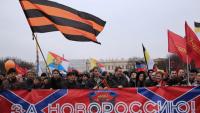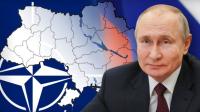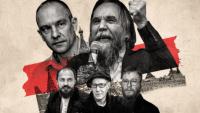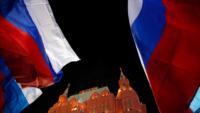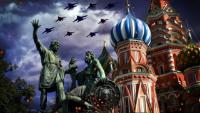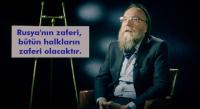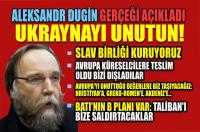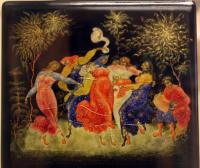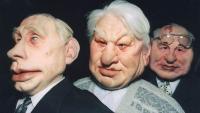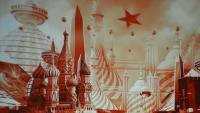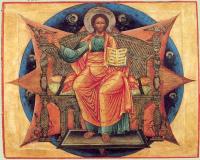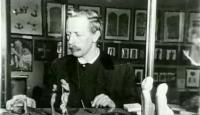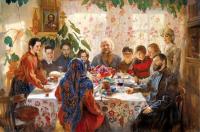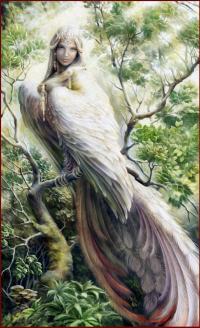Russia
The future of the Ukrainian state
16.02.2022 - Amid the stormy propaganda that the West has unleashed on the Ukrainian issue – ranging from a call for the repatriation of US and European citizens in Ukraine to the media leak that the Kiev government has begun to move the government infrastructure and the most important institutions to the western border of the country – it is difficult to think or talk about anything else.
Russian views on the Ukrainian crisis
11.02.2022 - Center for Arab Eurasian Studies of the current explosive crisis between Russia and the West, one of its chapters is now taking place in Ukraine; Where each party reviews its strength and capabilities, the Center's Russian Studies Unit presents, in this press investigation, a summary of the most prominent and most important Russian views on the latest developments surrounding that crisis after Moscow obtained a written response from the United States and its allies regarding the security guarantees it requested. The report is the opinions of several prominent Russian experts who singled out the Center exclusively. In this context, the Center's management extends its thanks and appreciation for the time and effort of these experts
The Growing Confrontation between Russia and The West
04.02.2022 - Current political ideologies emerged under the protection of Modernity and ended up crystallizing during the 19th and 20th centuries in the heat of wars. The first political ideology that emerged was liberalism, which was nothing more than a reflection of the values and laws created by bourgeois society.
Decree No. 809: the foundations of a sovereign ideology are laid
Dugin: Rusya liberal nazizmin tek kutuplu dünya düzenine isyan etti!
Aleksandr Dugin'den zehir zemberek yazı: Ukraynayı unutun!
Rus milliyetçi entelektüellerin yeni internet sitesi zavtra.ru'daki son yazısında Aleksandr Dugin, Rusya'nın Ukrayna üzerindeki niyetlerini tüm çıplaklığıyla açıkladı. Dugin'i göre artık Ukrayna Doğu Slav Birliği'nden ayrılamayacak.... Batının B planı terörizm... Afganistan'dan ABD'nin ayrılması Taliban'ı güçlendirip bize güneyden saldırtmak için!..
Baron Ungern: God of War
Ungern gradually devised a desperate geopolitical plan to create a unique zone in Asia, or more precisely in Mongolia, free from both Bolshevik influence and the troops of the profane West. It would be a unique world in which the ancient laws of the Sacred Tradition would be in force. Ungern was familiar with the books of Saint-Yves d’Alveydre, and knew of the existence of the secret, underground country of Agarttha, where the laws of time are not in effect and where the King of the World, the Chakravarti, resides. Like the Knights Templar, who not only guarded European pilgrims from the Saracens, but also protected the great mysteries of spiritual knowledge from degenerate Catholicism and the secularizing French monarchy, Ungern aimed to create a special zone between the shrines of Tibet, where according to legend lies the entrance to Agarttha, and the rest of the world.
THE GREAT PHILOSOPHER YURI MAMLEEV
Landscapes of Mamleev are infernal, you might say. I would write better about something bright, about how all of us to be. Mamleev did not choose the world in which he was born. What he saw, and that was singing. He saw mostly horror. And not because Heidegger believed that only in a state of horror one realizes the fact of his being in the world, grasp of the structure of Dasein. Mamleev was not from philosophy to reality, but from reality to philosophy.Seeing the infernal around him, clearly and vividly aware of himself in hell, he just cried, squeezing a scream, hoarse, and it became in his mouth, art, philosophy, literature. Plato and Aristotle unanimously said that philosophy begins with wonder. Needless to say, Yuri Mamleev was really surprised, one might even say, unpleasantly surprised by the fact that he found around himself in the incarnation in the body. And kept it fresh feeling horrendous surprise until his death. He never got used to the world, despite the fact that he lived in it for a long time.To death it was something naive and childish.
HORIZON OF THE IDEAL EMPIRE
Women will love the Empire and cherish it every morning in greeting the sun. Morality will change. The word “evil” will be excluded from the lexicon along with all bad expressions. Instead of them will be introduced the gradual concept of “less good.” A less good person stole a bun at the market. He deserves less love and less respect than the one who asked for a bun and was given one. With a gentle smile. Everyone will smile and laugh at funerals, for since this world is so beautiful, what about the next…And then death will be comprehended as a return to the eidos (επιστροφή).
Anti-Communism And Anti-Fascism Are Tools Of Capitalism
In the post-Soviet period, communism went through several stages in our society. First, after the fall of the USSR, there were Marxist circles that still had inertia, which did not surrender, believing that the catastrophe was temporary. In this passive attitude, an indecisive and conformist nostalgia became a form of suicide and led to their disappearance. There were also radical communists in the 90’s who tried to get together – among them were passionate people who were not significant during the USSR itself, but in the 90’s they turned out to be honest people with integrity – but gradually they also ceased to really be. For a while in Russia, we were without communists.
IT’S TIME FOR SUPER-PUTIN
Putin is the compromise. If he is gone, there will be no compromise. It is clear that the elite is so resourceful and mean that it will try to adapt to another system, but this does not fundamentally cancel the fact that Putin cannot decisively influence the future. In a sense, he has already influenced it. And this influence is very positive: he showed that the 90s have an alternative, that it lies somewhere in the plane of patriotism (Second Chechen, Munich speech, “Our Crimea”, etc.), and this, in fact, is a grandiose accomplishment. But at the same time, Putin did not give the form and institutionalization of this patriotism, did not change the foundations of the state laid just in the 90s, did not carry out the rotation of the elites, ignored the popular demand for social justice. The established regime in the eyes of the people as a whole is much better than it was in the 90s (hence its legitimacy), but definitely worse than what is required. While Putin is in place, his merits cover the shortcomings. Once he leaves, a delicate and rather unnatural balance will collapse. By the way, Surkov is not right about de Gaulle: his legitimacy, relying on his role in World War II and the Resistance, lasted only until the early 70s, when he remained in power, and collapsed during the events of 1968, which abolished Gollist conservatism and established new socialist paradigm. Later, de Gaulle remained only nostalgia and simulacra.
The Solar Hounds of Russia
Every thing is what it is thanks to its borders. After all, it is they that separate it from another thing. This distinction carries the most important meaning of the concept of the border not just for international law, defense doctrine, or the structuring of a country’s armed forces, but also for philosophy as such. The border is not just an instrument of philosophy, but its essence, seeing as the highest philosophical concept – transcendence -in Latin literally means “that what lies on the far side of the border”.
The border externally reflects that which lies inside it, while simultaneously confining the essence of the thing in its confrontation with other things. The border is something sacred. The ancient Greeks knew a special god, Terminus, whose name meant ‘limit’, ‘border’. This was not just the guardian-deity of borders, but a “border-deity”, a kind of special, sacred concept that played a central role in the worldviews of the ancient Indo-European peoples.
In magic, there also exists the important concept of the “Guardian of the Threshold”, a special being that is located at the intersection of two worlds: the beyond and the present, the vulgar and subtle, that of life and that of death, the waking world and the dreaming world. This is the very same ancient Terminus, with only slight modifications.
The Pole of the Russian Circle: Moscow’s Place in the Sacred Geography of Russia
Questions of geography are very tightly linked to psychological archetypes. Every people, every civilization, every culture sees and understands space in its own unique way. There always exists a kind of code that serves as a distinctive trait of the national territorial myth.
Reconstructions made by modern historians of religions, sociologists, and anthropologists allow us to speak of an entire science (sacred geography) that predetermined our ancestors’ perception of the surrounding world in its spatial dimension. The norms of this sacred geography formed the foundations of epics, biographies, legends, traditions, myths, and fairy tales.
As the rational aspects of life developed, this sacred geography became part of the unconscious, thus determining deep psychic archetypes, rudimentary reactions, and the typology of slips and dreams. Having disappeared from the ancient stage, the geography of the myth passed into the sphere of subconscious reactions; however, this does not mean that it lost its hypnotic power.
There are peoples who visualize their homeland, their country, as an island. Others see it as a plain hemmed in by mountains. Still others see it as a space between two or more great rivers, or as an uninterrupted mountain range, or as a coastline, and so on and so forth. It is on the basis of this sacred geography of the homeland that an idea of the entire cosmos is formed.
Moscow as an Idea
Moscow is not just a great city, not just a great capital, not just the symbol of a gigantic Empire. Moscow is a basic concept of theology and geopolitics.
Moscow has been called the “Third Rome” not merely as a metaphor or self-indulgent manifestation of purely national pride. Everything goes much, much deeper. Orthodoxy knows the special teaching of the “three Romes.” The first was imperial Rome before Christ, the same state on whose territory the Son of God set foot on earth. This Rome was a universal reality that united enormous spaces and manifold peoples and cultures in civilizational unity.
The Second Rome, the New Rome, was Constantinople, the capital of the Roman Empire, which had accepted the blessing of holy christening. From that point forward, the Roman Empire acquired a strictly ecclesiastical, deeply Christian meaning. The Orthodox Emperor (Basileus), as head of the Empire, was identified with the mysterious person from the Apostle Paul’s Second Epistle to the Thessalonians: the “withholder”, “katechon”, who in the end times is fated to prevent the “coming of the son of perdition.”
The coming of Christ is a central event in world history. Everything that preceded it was a presage. What followed it was the universalization of the Gospel. And, in the Orthodox conception of the world, the center of history in the Christian era was Rome, the New Rome, Constantinople and its ruler, the Orthodox Basileus.
We are the Church of the End Times
The Romanov period saw a continuous process of Russian Orthodoxy’s silent return to pre-Petrine times; this was not a conservative-revolutionary path (as with the Old Believers), but a conservative-evolutionary one whose existence was due mainly to the archaic nature of the provincial clerics and the multitude of simple parishioners. In a certain sense, the enthronement of the antichrist in the Church did not fully succeed, despite the fact that during the individual intervals of Peter the Great’s rule the impression formed that this was taking place. Still, because of some higher reasons, the final chord was delayed, even though the forces of the antichrist multiplied tenfold.
Although it was at the price of compromise and adaptability, Russian Orthodoxy maintained its unity, the legality of its hierarchy, eucharistic succession, and loyalty to the fundamental norms of patristic tradition. The Saint-Petersburg stage was characterised by a certain split in the official Church. At the lower levels it moved towards the Old Faith, i.e. towards Orthodoxy in its purest form. At the top, it was oriented towards Western adjustments and norms, as official theology repeated the model of Catholic-Protestant teachings, and the general spirit was fully apostate. Nikon’s reforms significantly damaged both rites and liturgical books. The synod became an administrative agency in a bureaucratic, profane government.
Christian Metaphysics: The Essence of the Problem
Christianity is that tradition whose metaphysical dimension has been studied least of all. This is quite a paradox since one would think that such a deep study of Christianity, the religion of the West, would attract all those interested in metaphysics and who, following Guénon, are trying to make sense of the most profound aspects of Tradition. Nevertheless, the disputes surrounding Christianity in Traditionalist circles are, as a rule, limited to fairly secondary, practical issues regarding the virtual initiation of the sacraments, the absence of an idea of cyclical time, etc. In all of this, one can see a tacit consensus among Traditionalists that Christianity is nothing more than a reduced, incomplete tradition whose esotericism has been practically lost, and whose metaphysical content cannot be detached from the dense veil of exoteric scholastic theology and the hazy subjective intuitions of mystics. All attempts to identify any consistency between the basic principles of Christianity and the conceptual categories of other, more metaphysically developed traditions (primarily Hinduism) have yielded rather poor results and have been based on strained interpretations and biased urges to arrive at any cost at conclusions which match Guénon’s own ideas.
Orthodoxy, for its part, despite having preserved ontological and metaphysical wholeness, from a certain time onward could no longer assert its metaphysical content (i.e., actual Christian metaphysics) in clear categories. Shortly after the “Palamite disputes” when Orthodox esotericism experienced its last dazzling rise in history, this line was somewhat marginalized and “frozen”, as priority was given to the exoteric sides of the Church. In the late 19th and early 20th centuries, many Russian theologians and even secular philosophers, intuitively surmising the special metaphysical nature of Orthodoxy, attempted to formulate certain principles for reviving the forgotten dimension of this tradition. However, most of these attempts did not yield serious results since none of them were familiar with the works of Guénon. Hence why only now, in our opinion, is it possible to acquire adequate knowledge of the most important proportions of the structure of fully-fledged metaphysics.
Horizon of the Ideal Empire
It will be a huge Empire. The richness of the landscape and the diversity of the polities will be intrinsic to the state. The Empire principle must be rehabilitated. Besides the trifunctional system (philosophers, warriors, and farmers), the Empire can include enclaves of a variety of creatures from Amazons to two-headed, bird-legged, and headless beings, gypsies, Evenki, etc. There could even be a mermaid republic or Veche forest gatherings governed by an assembly of Domoviye and Leshie. We can also imagine a congress of Angels or Tatar Kurultai.
A plurality of types of political and anthropological creativity should be encouraged.
TV and the press will be cancelled, as they are always spouting some kind of meaningless nonsense.
Clothing will have its own meaning. The body is the wrapper of the eidos, and the clothes are the wrapping of the body. Everyone will have different clothes, but all colorful and astonishingly beautiful, so that people pay attention to them. People will notice clothes and judge by clothes. There will be an absolute cult of clothing. People will spend most of their time getting dressed and changing.
Food will be the most ecologically pure, and distributed freely, as a gift. There will be an exceptional lot of sausage, cheese, and hazelnuts in the Empire.
On the Question of Russian Runes
There exist several points of view as to what runes are. Some believe that runes are an altered version of the Latin alphabet that appeared in the 5th-6th centuries among the Scandinavians and Northern European Germanic peoples. Others suggest that runes were the ancient characters used for divination and recording texts which emerged only at a later stage and under the influence of Latin writing. These two points of view on the nature and origin of runes are considered to be the “scholarly” and “orthodox” ones.
But there is another theory of runes proposed by the German scholar, Professor Herman Wirth. We should mention from the outset that this theory is not recognized by broader scholarly circles. The reason for this neglect of Wirth is not so much his paleo-epigraphic and runological works as his assessment of the text famously known as the Oera Linda Chronicle, the story behind which resembles that of the Book of Veles. The Oera Linda Chronicle was discovered at the beginning of the 19th century and allegedly presented the most ancient history of the Germanic peoples (the Frisians) stretching back centuries to many millennia. The text was written in a special quasi-runic script and contained tales of pre-Christian mythology and the sacred history of the Germanic people. The Book of Veles (discovered only at the beginning of the 20th century) represented a precise analogue of the Oera Linda Chronicle, only applied to the Slavs.
The Rus of Rurik
The point is that both the Slavs and the Rus (like the Franks and Celts) ethnologically belonged to one Northern Aryan ethnos today known as the Veneti. In the days of old, one could stumble upon the name mentioned by Strabo – Vindelicum or Vendelicum (and the Baltic Sea was the Sinus Venedicus). Moreover, one of their names was Franks (the “free ones”) and the other was Slavs. As Eckhard wrote, “The Franks once dwelled near the Baltic Sea, where there is now the Vagria” (Franci olim ad mare Balthicum, ubu nune est Vagria). It should thus be clearly borne in mind that all of these ethnonyms are from later times. “The Franconian Slavs,” writes the 19th century Russian scholar Y.I. Venelin (Gutsa), “did not call themselves Vindelicum, just as they did not call themselves Slovene as the name existing only in ethnographic books. The very word Franks is a modern ethnonym derived from one of the names of the kings who ruled the ancient Vagria called Reges Francorum and who, according to Fredegar and the later chroniclers, were the descendants of the Trojan kings (the line of Priam). These are the Trojan Veneti settlers who formed the ruling, princely caste of whom Polybius wrote. According to him, they “differ little from the Celts, but speak their own language. The writers of tragedies often mention this people and speak of its many miracles.”
The Dormition of the Mother of God
The symbolism of the Dormition icon (if we juxtapose it to the Mother of God icon) also has analogies outside of a Christian context. The clearest such similar spiritual concept of the structure of being is reflected in the Chinese symbol of Yin-Yang, in which the white dot against the black background signifies the diminishing of the spirit in matter, while the black dot against the white background is, conversely, matter in spirit. However, the Chinese tradition is characterized by contemplation and and the absence of an eschatological orientation. Thus, the Chinese are inclined to consider this symbol as a sign of eternal harmony while Christians see ontological plans in an historical and eschatological perspective, hence Christianity’s distinctly ‘dynamic’ character supposing the personal, volitional engagement of man in the outcome of the fate of the spirit. The Chinese believe that this volitional aspect is not so important insofar as the Tao ultimately arranges everything in the best way. Undoubtedly, similar symbolism can be found in many other traditions in reference to the correlations between the material and spiritual worlds, but the Chinese example represents something so clear and comprehensive that all similar parables can be reduced to it.
TOWARDS A GEOPOLITICS OF RUSSIA'S FUTURE
By all principle parameters, the Russian Federation is the geopolitical heir of the preceding historical, political and social forms that took shape around the territorial of the Russian plain, from Kievan Rus through the Golden Hordes, the Muscovite Czardom, The Russian Empire and the Soviet Union. This continuity is not only territorial, but also historical, social, spiritual, political and ethnic. From ancient times, Russian government began to form in the space of the Heartland, gradually expanding more and more, until it occupied the whole Heartland entirely, together with the zones adjoining it. This spatial expansion of Russian control over Eurasian territories was accompanied by a parallel sociological process: the strengthening in Russian [Russkii] society of "land-based" social arrangements, characteristic of a civilization of the continental type.
Russian Easter
The faith in Christ is the Russian faith. It can be objected: Orthodoxy is the universal Church, it is open to all mankind. Identifying it with the Russians means to narrow its value, reduce it to the national religion. There is a notion of the phyletism heresy, religious “love toward a nation.” For the enemies of Orthodoxy, especially for Western Christians, it is the central argument against the Byzantine Empire and against Russia. Unfortunately, in 1872, the patriarch of Constantinople, the head of the Phanar fell for it. But what do they know? They abolished the sacred Julian Calendar, giving up the basics of Orthodoxy for the Uniate... What do they know, my friends?..
Russia and Virgo Solar
As the point of departure of our investigation we shall take the extremely interesting data concerning the sacred geography of the southernmost (or, more precisely, the south-western) territorial sector of Gardariki (the Galician principality) gathered in the book Hyperborean Dacia [13] by the Romanian Traditionalist author of a Guenonian orientation, Geticus (Basil Lovinescu). In this work, the author convincingly demonstrates on the basis of sacred toponymies and a deep analysis of Romanian folklore that ancient Dacia (modern Romania and Moldova) was once the sacred center of the Hyperborean tradition, albeit secondary in regards to Polar Hyperborea which was far more original than other indirect spiritual centers of traditional civilizations. In our opinion, the thesis of Hyperborean Dacia looks quite convincing and we would especially like to dwell on the mystery of the Danube delta which, according to Geticus, was the location of one of the main sanctuaries of Hyperborean Apollo.
The author of Hyperborean Dacia notes the following peculiarity of the Danube delta and its cult center: river Danube flows into the Black Sea on the 45th parallel, i.e., on the belt dividing the entire northern hemisphere in half. Thus, the cult center of Apollo in Dacia was located in the far north for the entire southern half of the northern hemisphere whose establishment has only recently become known to modern historians of civilization. We note that the 45th parallel in general plays an extremely important role for Eurasia and in the far West. In France, two of the most important sacred centers, Lyon (the “city of meadows, i.e., the center of the geographical spiral of the druids as examined in Louis Charpentier’s book The Giants and the Mystery of the Origin [14]) and Grenoble (the “land of the Dauphins” [15] whose solar, Hyperborean symbolism was researched by the scholars Eugene Canseliet – Sevren Bafrue and Guy Beatrice in the book Land of the Dauphin [15]). At the same time in the Far East, in Mongolia, at approximately the same latitude is located the sacred center of Genghis Khan’s empire, the city of Urga. In addition, it is interesting note that the borders of the Russian Empire also more or less followed this parallel over a gigantic space resembling a sinusoid with a recess in the South in the Caucasus, Kazakhstan, and in the Pamir mountains, and a rise in the North in South-Eastern Siberia, Altai, and across the Amur River. In addition to such an important parallel at which the center of the Apollonian cult of “Hyperborean Dacia” was located, what is also extremely important for us is that the longitude of this place was 30 degrees east. It can be said that this meridian, in its northern part, was the axis of the Slavs’ settlement. To its west were the Poles, Czechs, Slovenes, Serbs, Croats, Ukrainians, and Belarussians, and to its east are the Great Russians. Thus, in addition to the “extremely northern” location of “Hyperborean Dacia” in relation to the mediterranean world, the extreme South of its situation can also be considered in regards to the Slavo-Baltic-Scandinavian world and Gardariki Rus. In fact, the mouth of the Danube was always the southern sacred-geographical pressure point of the “masses” of the Slavic, Russian world to the north.
The Russian Heart of the East
Sacred geography differs substantially from conventional, physical geography. We are accustomed to consider the earth as an orb, as a globe (in Latin, globus means “orb”). For us, the North is the top of the orb, and the South is the bottom. A globe can be rotated and, consequently, concepts of East and West slip away from our geographical attention. But when we present our earth as rotating in the solar system and in outer space, we generally digress from such concepts as cardinal directions. All of this seems to be so conventional! Understanding the world as standing on three pillars and the earth appearing to be a disk are relics of the “dark ages.”
For a long time, scientific discoveries which have opened new horizons and succeeded each other at a furious pace have been accepted by people uncritically and with excessive enthusiasm. In turn, many have come to treat our ancestors’ map of the world with disdain and disgust and we have been inclined to consider our ancestors to be “dark,” “wild,” “primitive,” or having only recently ceased to be “apes.”
Such a positivist attitude quickly finds itself confronted with a number of contradictions. The development of science has arrived at the problem of consciousness and the human factor in relation to natural phenomena. Here everything changes. It turns out that the mythological archetypes and systems of consciousness formed by culture, history, the environment, geography, and language have a strong influence on scientific methodology to the point that they “deform” these so-called “objective” material studies.

